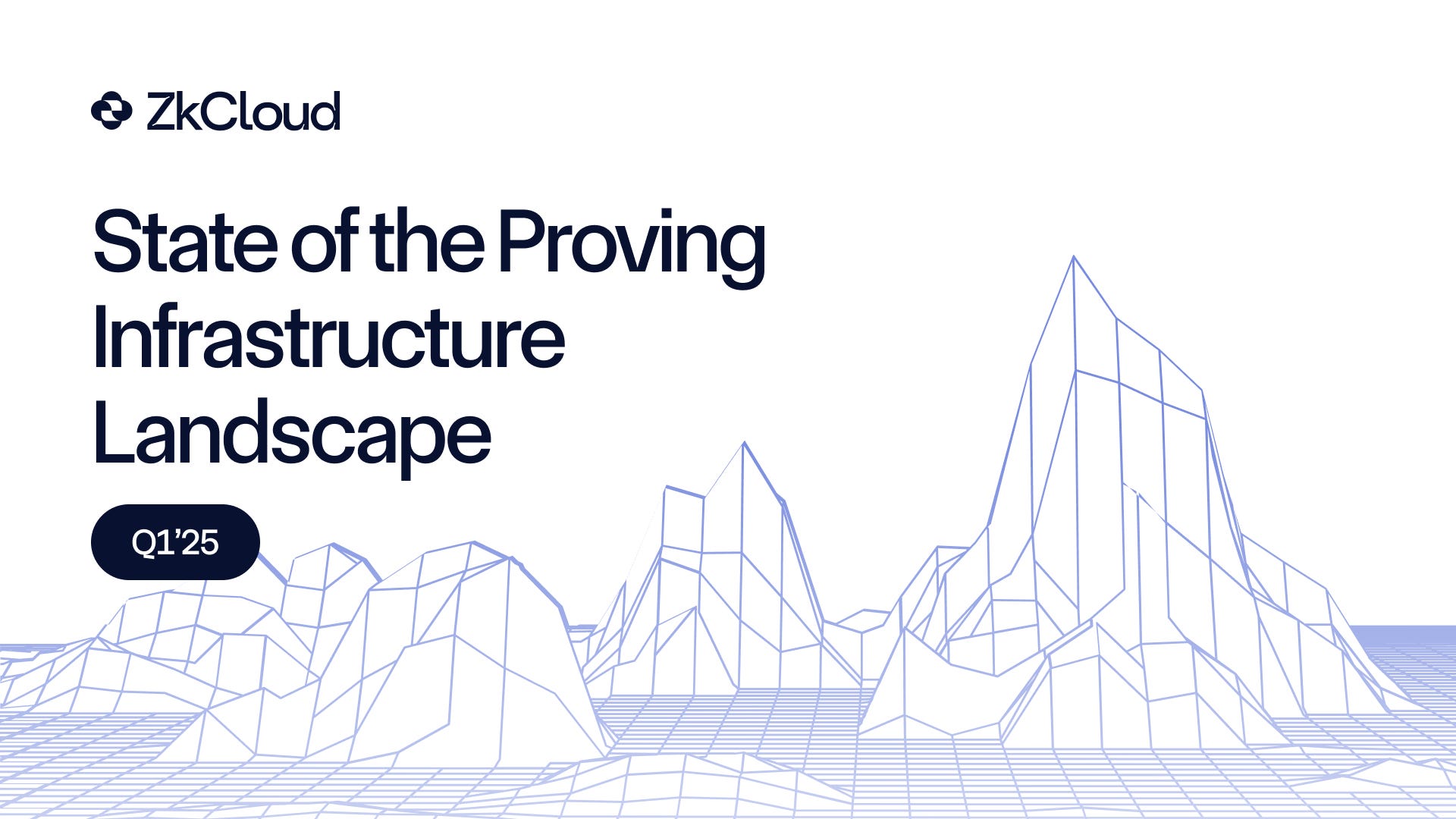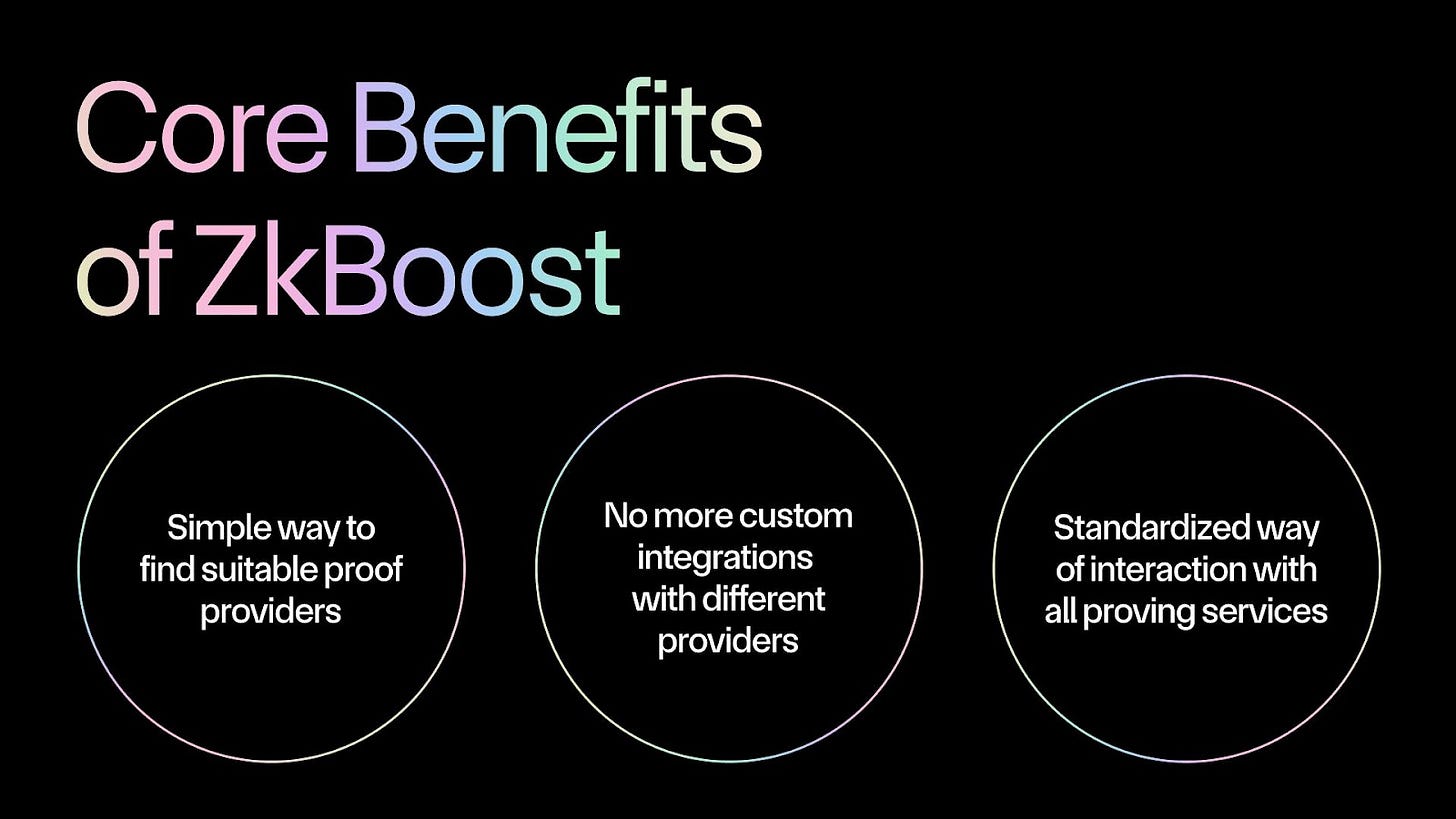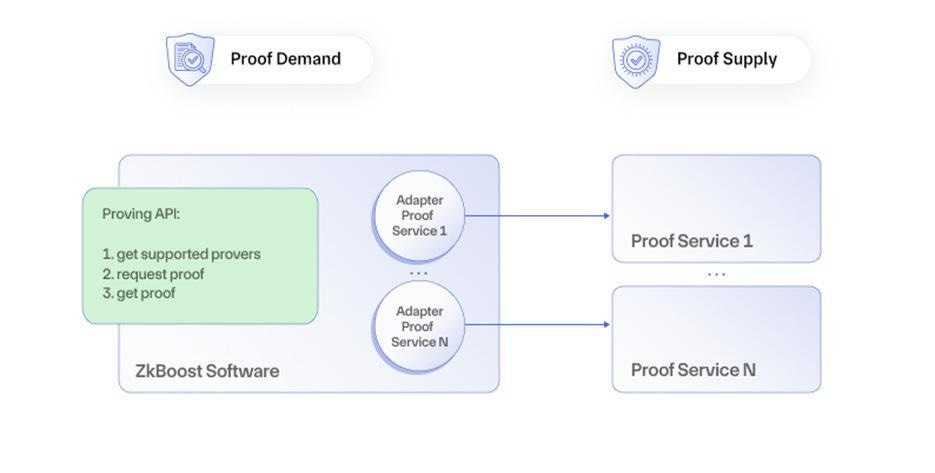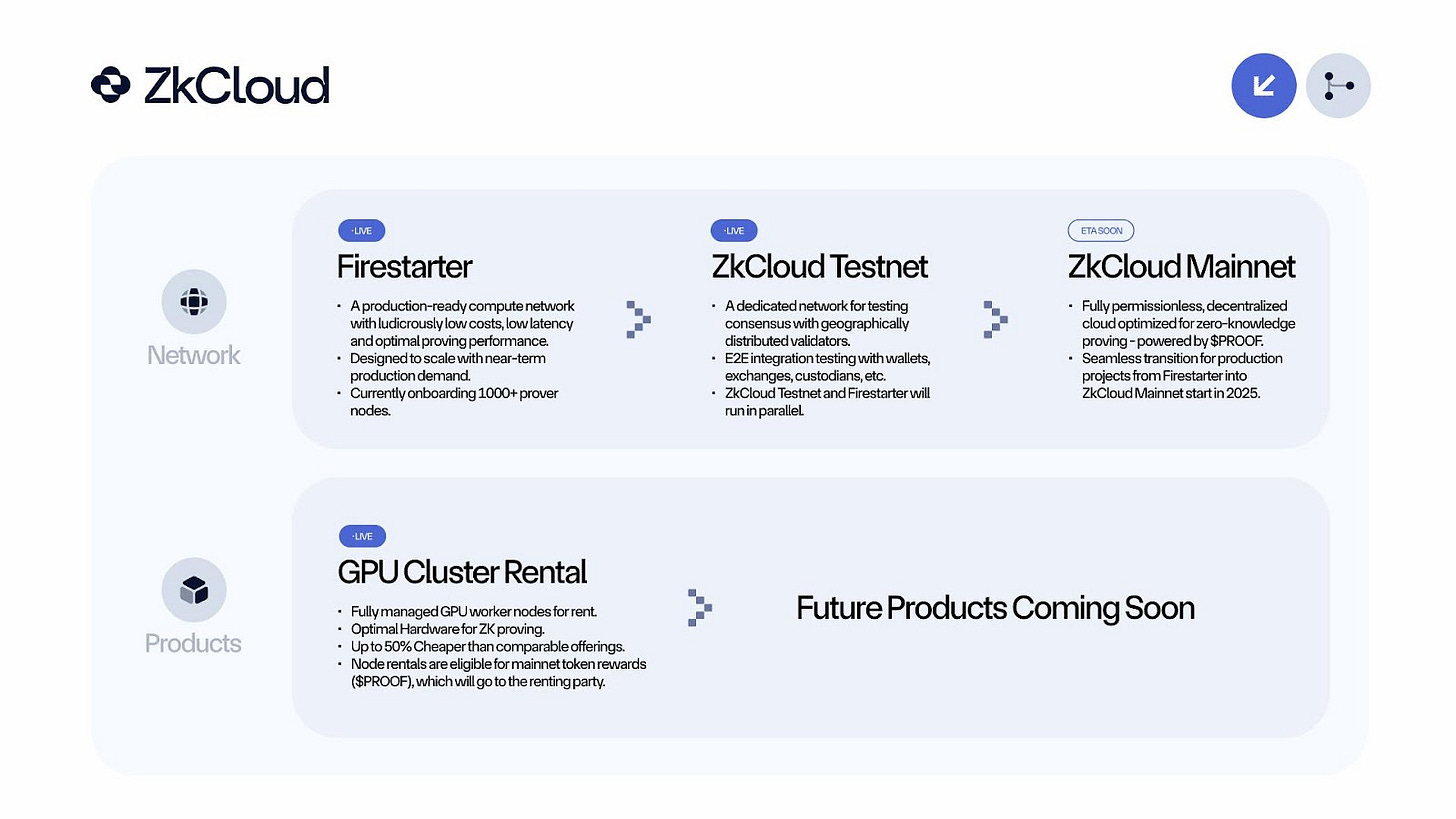State of the Proving Infrastructure Landscape - 2025Q1
Optimistic is dead, long live ZK
If you’re a project interested in renting ZK compute, start now with credits.
TL;DR
In the latest edition of our report, we explore the topic of snarking Ethereum, discuss new developments in prover decentralization of L2s, go through project updates in the proving infrastructure landscape, and look into how the unified proving client, ZkBoost is shaping up.
Recap of Q4 2024
In our Q4 report, we explored the new developments related to ZK- and validity L2s on Ethereum:
Besides TEE proofs, Taiko added validity proofs to some of their blocks, implementing a multi-proof-based security model.
Scroll announced their rollup stack, the Scroll SDK, allowing teams to build validity rollups based on Scroll’s tech.
Aztec launched their Sequencer & Prover Testnet to test decentralized sequencing, governance, and proof generation.
We explored the new developments in the proving infrastructure landscape, diving into ZkCloud’s scalable prover network, Firestarter, the testnet of Nexus Network, the prover networks of Zerobase and Lagrange, and also the Succinct Network’s whitepaper.
And, we also took a deep dive into the economic security behind proof generation:
We compared proof-mining with Bitcoin-mining,
Explored the role and purpose of staking,
Analyzed the risks that come with restaked economic security, and
Also looked into possible alternatives, such as reputation systems, performance-based rewards, and capacity and availability verification, the combination of which could mitigate the risk of Sybils in the network, force-remove non-delivering prover nodes, and ensure liveness and availability, while providing sufficient security guarantees, without the elevated entry barrier and opportunity cost that staking introduces to prover networks.
Now let’s look at what happened in Q1 2025.
Snarking Ethereum’s execution
The Ethproofs initiative
January has seen the launch of a key initiative: the Ethproofs platform, aimed at advancing Ethereum's scalability and security through zero-knowledge technology. Ethproofs has been kicked off by the Ethereum Foundation to accelerate the snarkification of Ethereum, and create a public platform to benchmark the performance of zkVMs on mainnet blocks, and allow tracking the current status of snarking Ethereum live on the production interface of Ethproofs. Both zkVMs and proving services are among the current participants: ZkCloud, Succinct, Snarkify, and ZKM are active on the platform, while many other teams are preparing to join the initiative.
Since its launch, Ethproofs has been focusing on proving Ethereum blocks ending in "00" every 20 minutes using a single-machine setups, with a live proof explorer that tracks performance, latencies and costs (the latter being expressed based on the hourly price of selected AWS instances and not the actual cost of the participants).
The roadmap for 2025 includes multiple enhancements: by Q2, the platform aims to increase proving frequency to blocks ending in "0" every 2 minutes, eventually targeting real-time proving (latencies under 12 seconds) by introducing multi-machine proving, in-browser proof verification and more.
ZkCloud proving every Ethereum block
At ZkCloud, we joined the Ethproofs initiative in late March and have been regularly posting proofs since the beginning of April. However, we went one step further: not only are we proving every Ethereum block ending in "00" every 20 minutes, but since early April, we have been continuously proving every Ethereum block.
Proofs generated are posted to and can be publicly tracked at the staging interface of Ethproofs platform live.
ZK proving the entire execution of Ethereum has been viewed as prohibitively expensive. We want to test that assumption and prove the opposite: blockchain-scale proof generation is affordable, and the endgame for blockchain scalability is here today.
All ZK proofs generated and benchmarks developed will be available to researchers and developers, advancing the collective knowledge of the entire Ethereum ecosystem and supporting future innovation.
The current approach to Ethereum proving and Vitalik’s RISC-V proposal
Ever since real-time proving of Ethereum became a potential reality, teams have been focusing on running the current EVM execution in a zkVM (mostly RISC-V-based). This requires translating EVM bytecode into RISC-V to generate zero-knowledge proofs, introducing inefficiencies; the optimizations so far have been centered around accelerating this at both software and hardware levels to get to real-time proving.
Recently, Vitalik published a proposal with a new approach to snarking Ethereum: it proposes replacing the EVM with RISC-V to eliminate the translation layer, potentially achieving very significant improvements in proving times. RISC-V has many advantages, and it is also the most popular ISA used by zkVMs by far:
However, this approach also comes with trade-offs: RISC-V–based zkVMs may often share a significant portion of their codebase. This commonality means that a soundness bug discovered in one implementation could potentially impact others as well, creating systemic vulnerabilities. And there is even more to it.
Maintaining prover diversity on Ethereum
Ethereum has had diversity in its client software: implementations such as Geth, Nethermind, and Erigon increase security by eliminating single points of failure.
In the current snarking approach, where all zkVMs are running the EVM execution in the VM, ZK-prover diversity is a given: a bug in RISC-V-based zkVMs could be mitigated by other VMs using different ISAs, such as the CairoVM, contributing to a more secure, multi-proof environment for Ethereum execution.
Can ZK-prover diversity for Ethereum be maintained when RISC-V replaces the EVM? Migrating the EVM to a dedicated ISA, like RISC-V, would potentially narrow down the surface for diversity in prover implementations, thus limiting the network's resilience against soundness bugs.
One thing is for sure, though: the extensive debates and the collaborative thinking that Vitalik’s post triggered, along with the creative intuition born thereof, are extremely beneficial for Ethereum.
New developments and prover decentralization among L2s
Starknet’s decentralization roadmap
Starknet announced its multi-phased roadmap to decentralization in 2025. The decentralization of proof generation is not treated as a separate phase, but rather as an inherent part of sequencer decentralization.
Throughout 2025, Starknet will migrate to a new stack based on the next-gen Apollo sequencer and the Stwo prover, both of which will be open-source. Stwo’s efficiency drastically reduces the computational resources needed to generate STARK proofs, setting the stage for sequencers to be fully responsible for maintaining and securing the network by producing, attesting, and proving blocks by the end of the year, in phase 4 of the decentralization roadmap.
This approach is unique to the L2 space: most other provers require significant hardware resources, and therefore, proof generation is being outsourced by specialized entities. With the more modest resource requirements of Stwo, it is still to be seen whether sequencers will prove blocks themselves or outsource proving to third-party proof providers.
Scroll migrating to the OpenVM prover
Scroll announced adopting a zkVM prover, OpenVM, to verify their mainnet. They have been collaborating with Axiom to design OpenVM with a focus on modularity and customizability. The new prover is expected to drastically decrease proof generation time, allowing faster finality and lower proving costs. With the network upgrade in April (already completed last week), Scroll aims to become a stage-1 zk-rollup. The team is also working on enhancing the SDK and Rust package support for OpenVM to make it easier for developers to build their applications on the platform.
ZKsync implementing TEEs to enhance security and interop
In January, ZKsync announced moving towards a multi-proof future and implementing TEE proofs. ZKsync already uses ZK to prove the validity of the chain. The ZK proofs are a necessity for the chain’s finality, however, proof generated in a trusted execution environment could act as a backup to further increase network security. In addition, TEE proofs could allow faster interoperability among Elastic chains, because they can be computed much quicker than ZK proofs.
Kakarot: building an EVM proving engine & proposing prover input standardization
After implementing an EVM in Cairo in 2024, Kakarot announced its strategic decision not to proceed with the Starknet deployment. Instead, their focus has shifted to building the most efficient and high-performance EVM proving engine. This proving engine serves as the basis for Kakarot’s vision to increase interoperability and efficiency by enabling the real-time proving of EVM-compatible networks.
In addition, Kakarot published a proposal for standardizing zkEVM prover inputs. Various zkEVMs exist, such as Keth by Kakarot, Zeth by RISC Zero, and RSP by Succinct, and currently, all accept unique, vendor-specific inputs. Standardizing the prover input format would allow for a neutral, multi-proof supply chain, where the same input could be used for every zkEVM prover engine; and could also enable the creation of a standard interface between the execution layer clients and the different proving infrastructures.
Our take on prover input standardization
Kakarot’s proposal resonates very well with the overall goal of ZkBoost, a neutral and open-source proving client that may serve as a single, unified gateway to all proving services. In particular, it aims to be a translator for proof request submission: different zkEVMS and proof providers have specific requirements for the input format and how requests for proofs can be submitted to them. ZkBoost removes this complexity, acting as a translator between service interfaces.
Read more about the developments of ZkBoost in the next section.
ZkBoost: the unified proving client
In February 2025, the high-level architecture design was released for ZkBoost. ZkBoost is a unified client for outsourced zero-knowledge (ZK) proof generation, designed to reduce fragmentation and improve the user experience for proof outsourcing.
Several prover networks, proof marketplaces, or centralized proof providers have emerged in the past 12 months, creating a competitive proving landscape. Competition is beneficial for proof requesters, but it results in fragmentation, creating heavy complexities in proof outsourcing.
Without a unified interface, proof requesters, such as L2s, need to rely on custom, provider-specific integrations, making it difficult to switch providers or use multiple proving services concurrently.
What ZkBoost is?
An open-source proving client run locally: It is run by ZK projects as a local gateway, ensuring that they have direct control over their proof generation pipeline.
A unified interface for outsourced proving: As a unified interface for outsourced proving it can break down the technical complexity by allowing proof requesters to interact with every proving service in a standardized way.
A translator for request submission: Proof providers have specific requirements for how proof requesters can submit proving jobs to them. ZkBoost removes this complexity, acting as a translator between service interfaces.
A single gateway to all proving services: The proving API allows proof requesters to connect to all proving services uniformly. While proving services connect to ZkBoost through adapters, developed and maintained by the respective service providers.
ZkBoost provides a standardized way of interaction with all proving services: proof requesters have a single interface to request and fetch proofs from any proof provider, or even multiple providers in parallel.
To learn more about what ZkBoost is and what it is not, see our blog post. If you are interested in joining the ZkBoost Consortium and participating in building and governing ZkBoost, please reach out to Norbert from the ZkCloud team.
Developments in the proving infrastructure landscape
Boundless Testnet
RISC Zero launched the public testnet of their decentralized proof marketplace, Boundless. Boundless currently supports RISC Zero’s in-house zkVM, the R0VM. Built as a smart contract platform, Boundless allows proof requesters to submit requests on-chain by sending a transaction to the market contract. Alternatively, users can also submit requests off-chain through an order-stream server, with lower censorship resistance.
Proof providers submit bids to the proof requester. The bid-matching mechanism used by the market is a reverse Dutch auction. The public testnet of Boundless allows anyone with the right infrastructure and expertise to become a prover; as per the Boundless Explorer, 18 entities are currently participating in the Market as provers. According to the docs, prover incentives are not active in the current phase of the testnet, and provers are rewarded with user payment for the jobs they win in the auction process.
Succinct Network’s Testnet
After having released the Succinct Network’s whitepaper in Q3 2024, Succinct launched the level-1 version testnet of its prover network in February. This testnet allows users to deposit 10 USDC, generate proofs, and earn stars while playing games. The network is not yet open to onboard prover node operators: contributing compute capacity will be enabled in the next version of the testnet.
Nexus Layer-1
Nexus, building a zkVM and the Nexus Network to generate proofs for the zkVM, announced the building of their network as a Layer-1 protocol. The architecture of the Nexus Layer-1 consists of four elements: 1. the Nexus OS, which includes the zkVM and the Nexus App, 2. an execution layer, 3. a consensus layer, and 4. a storage layer to store the state of the L1 and its applications. Users can engage with the Nexus Layer-1 by connecting to the devnet to earn points, contribute compute via a CLI tool, or deploy an app.
Marlin’s proof marketplace: Kalypso
In January, Marlin released its proof marketplace, Kalypso. Kalypso is a circuit-agnostic marketplace that allows users to self-deploy their custom circuits by creating so-called “Markets”. It is also integrated with Oyster, Marlin’s TEE-based coprocessor network. According to the dashboard, the marketplace currently hosts one market and 28 node operators called generators, out of which only 12 have generated proofs as of today.
Generators on Kalypso must provide native stake or restaked assets on Symbiotic as economic security. The marketplace dynamically locks a portion of the stake based on the real-time demand for services. Only generators with sufficient available stake and compute resources will be considered for a proof request. The matching engine selects generators and allocates them proving jobs in proportion to the max proving time and proving cost they quote, and the proofs that they missed in the preceding 48 hours; i.e. the lower the proving time and cost, and the lower the number of proofs missed, the higher their probability of being selected.
ZkCloud Testnet for decentralized consensus
In February, ZkCloud launched Deluge, the testnet aimed at testing decentralized block building and validator onboarding for the upcoming ZkCloud Layer-1 mainnet.
ZkCloud’s scalable prover network, Firestarter, and the Deluge testnet run parallel: proof generation is already decentralized via Firestarter (with the team running all validators internally), and through Deluge, decentralized block building and consensus are being tested.
The ZkCloud mainnet will be fully permissionless, combining both decentralized proving and block production.
To ensure reliability and consistency, proving workloads will be migrated from Firestarter to ZkCloud mainnet over time, once the network is stable and all proving protocol implementations have been integrated.
Closing thoughts
Exciting developments have happened on the Ethereum snarking front. As the network evolves toward a SNARK-verified future, the biggest challenge may be to balance performance with resilience. The optimal path is still to be found, but ZK being the endgame is now the tangible reality of Ethereum.
At ZkCloud, we are committed to supporting Ethereum’s efforts to move from re-execution to SNARK verification.
Beyond Ethereum’s snarking journey, the broader proving landscape is undergoing transformative changes. The decentralization efforts of ZK-rollups like Starknet, Scroll, and ZKsync are setting precedents for how scalability, resilience, and trustlessness can be enhanced in practice.
Efforts such as Kakarot’s proposal to standardize zkEVM prover inputs and the development of ZkBoost show another key topic of 2025: improving the user experience in proof outsourcing. As more proof systems and prover networks emerge, seamless integration and a unified interface to all proving services become essential. ZkBoost’s architecture is a strong contribution towards an open, unified proving experience.
Finally, the rapid evolution of decentralized proving infrastructures, such as Boundless, Succinct Network, Nexus, Marlin’s Kalypso, and ZkCloud’s Deluge testnet, highlights the rapid evolution of the proving ecosystem.
A lot has happened in Q1, and we can’t wait to see how Q2 evolves.
Long live ZK!
Disclaimer:
The proving landscape is evolving day by day. If you feel we missed out on some important protocols or developments, or find any inaccuracies, please get in touch with Norbert from the ZkCloud team, and we can make the necessary changes.
___
About ZkCloud:
ZkCloud, built by Gevulot, is the first universal proving infrastructure for ZK. Generate ZK proofs for any proof system at a fraction of the cost. Fast, cheap, and decentralized.
Learn more about ZkCloud:
Website | Docs | GitHub | Blog | X (Twitter) | Galxe Campaign | Telegram | Discord







